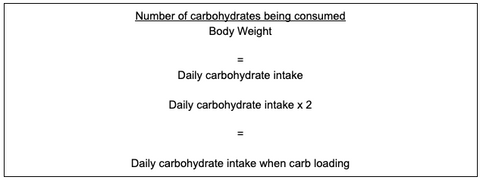How to Carb Load Successfully
Have you been thinking about carb loading for your next big event but don’t know how to start? Here are some tips and tricks to get the most out of it, so you can reach your next fitness goal and smash the competition!
What is Carb Loading?
Carb loading, otherwise known as carbohydrate loading, is the act of consuming more carbs than usual to increase energy storage. Carbohydrates are stored in the body as glycogen which is the body’s most accessible and preferred energy source. Excess glycogen gets stored in your muscles and liver which is accessed by the body during intense exercise.
Carbohydrate loading is used by athletes when they’re preparing for high-endurance activity (e.g. swimming or marathon running) as a way to enhance their energy stores and achieve better performance. In combination with low-intensity activities in their down-time, this will help to preserve the energy obtained from the high consumption of carbs.
How Do You Carb Load?
When it comes to carb loading, the first thing to consider is how much you will benefit from doing it. If you are partaking in activities that use more than 25% of your aerobic capacity, you will be able to make the most out of the additional energy storage. The next step is to calculate the actual number of carbohydrates you’re consuming and divide it by your weight to find how much your daily intake should be. Once this value is obtained, doubling it would equate the new amount of carbohydrates you need to consume on the daily.

Once you’ve calculated the number calories you need to consume, it’s time to choose what kind of regime you’d like to follow. There are programs lasting between 1-6 days but a recommendation would be a simple 2-3 day regime if you’re just getting started. There is no set number of days that will benefit you best, however during your training is the perfect time to experiment to see what combination gives you the most energy. This will give you the best indication on how to effectively carb load before the big day.
What To Eat and What Not To Eat When Carbohydrate Loading

Different body types require different quantities of carbohydrates but research does suggest 8-12 grams per kilogram of body weight. The ideal time to increase your carb intake would be the day before a competition or big event, and also around 24 hours after your last training session.
When finding foods to eat when carbohydrate loading, it is important to ensure they are high-carb but low-fat and low-fibre to refrain from going over your daily caloric intake.
Some foods we’d recommend to include in your meal plan for carb loading include:
|
RECOMMENDED FOODS: Think whole-foods, not soul foods! |
|
|
TO EAT |
TO NOT EAT |
|
Fruit juice and smoothies |
Muffins |
|
White rice |
Cookies |
|
Sports drinks |
Pizzas |
|
Pretzels |
Pastries |
|
Oatmeal |
French fries and chips |
|
Bread |
Creamy sauces e.g., Alfredo sauce |
|
Boiled potatoes |
Donuts |
|
Lean protein - fish and lean meats |
Brownies |
What Are the Pros and Cons of Carbohydrate Loading?
Pros:
- Energy stores are higher: This means you are less likely to become fatigued while participating in high intensity exercises, allowing you to train harder and longer.
- Build muscle mass: The body has more glycogen stores to turn to for energy rather than needing to break down muscle tissue to fuel your high intensity workouts.
- Prevent age-related muscle loss: Muscle loss tends to kick in over time as a result of ageing however, in combination with building muscle mass, this will limit the quantity being lost and ensure muscle mass is retained as much as possible.
Cons:
-
Higher Risk of Diabetes: If you have a pre-existing diabetes condition, it is important to consult with your doctor prior to carb loading, as there is a possibility that the high consumption of carbohydrates can spike your blood glucose levels. If you don’t have diabetes, it’s recommended to cycle on and off carb loading to lower your risk of developing type 2 diabetes.
-
Bloating and digestive discomfort: Fibre is a type of carbohydrate that is indigestible by the body. Generally, foods high in carbohydrates are also high in fibre, which can lead to bloating and digestive discomfort. This is why it’s important to eat more natural forms of carbs, rather than processed foods.
- Weight gain and water retention: Carb loading is not recommended if you’re not doing activities that will be using up more than 25% of your aerobic capacity because you’re not burning away the added calories. Participating in endurance activities ensure an output intensive enough to combat the caloric surplus.
Common Mistakes of Carb Loading
-
Carb loading when you don’t need to: Particularly when you aren’t participating in activities that require a caloric surplus, it will actually do more harm than good because you’re not burning away the calories. Instead your body will feel heavier and more fatigued.
-
Eating too much fat and fibre: This can lead to you feeling an upset stomach and finding that the food is too ‘bulky’ to consume over a short period of time. There are foods high in carbs but low in fat and fibre (like the ones stated in the table above), you will just need to do a bit more research into what will be good to incorporate into your own diet.
-
Eating the wrong amount of carbs: If you aren’t taking note of how much carbs you’re consuming in a day, this may result in you eating too much or too little. If you THINK you’ve eaten enough but actually haven’t, then this means you’d didn’t carb load. And when you eat too much you may end up completely changing your diet. The best thing to do is record how much you’re eating each day and adjust accordingly.
-
Eating new or unusual foods: It’s best to stay consuming foods that you’re familiar with because new foods may cause your stomach to react differently. This can cause pain and hinder your performance.
- Exercising too much: Although you’ll have excess energy stores due to the increased consumption of carbs, exercising too much will deplete them and result in limited performance on competition day.
Carb Loading and Exercise
While carb loading, it’s important to continue training at a light intensity to maintain consistency and cycle through the glycogen stores leading up to the big day.
Some examples of light intensity training that you can do is:
-
A walk on the treadmill for 30 minutes or even a slight jog if you’re feeling up for it.
- Some dynamic stretches and light resistance training with some power bands to maintain flexibility and movement.
Hopefully these tips and tricks can help you get started. Happy Carb Loading!










































Leave a comment